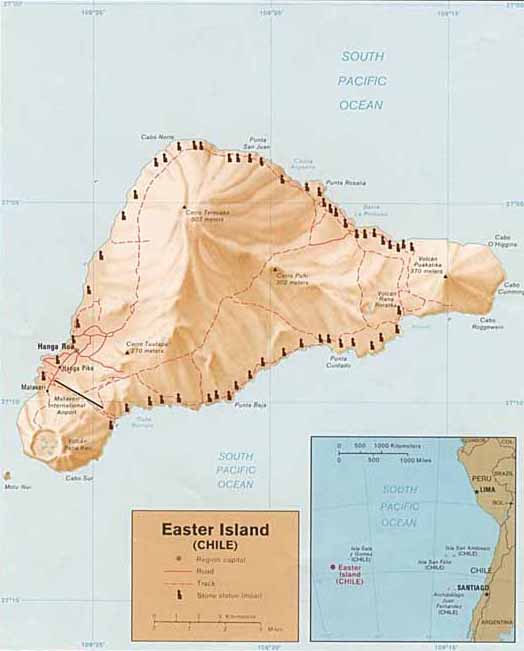
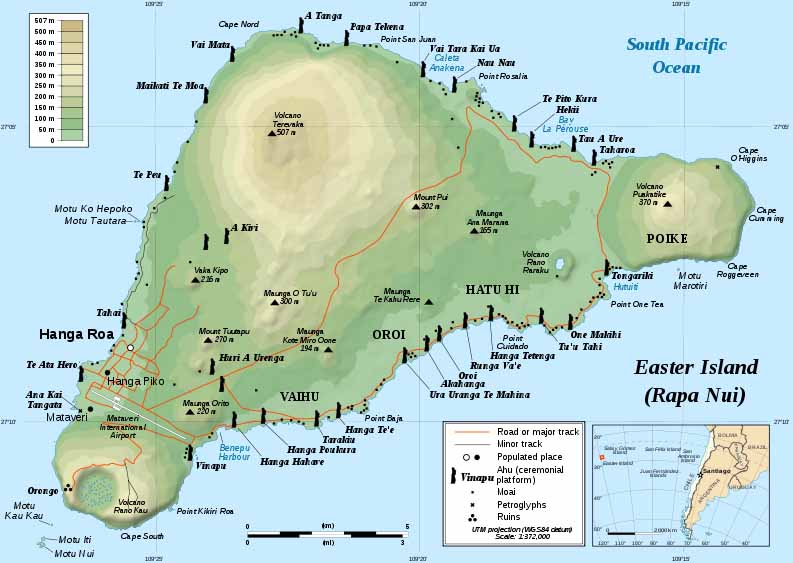
Native Flag of Easter Island - Reimiro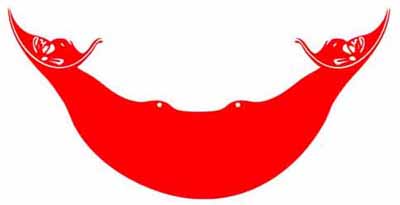
Easter Island is the world's most isolated inhabited island. It is also one of the most mysterious. Easter Island is roughly midway between Chile and Tahiti. The triangular shaped island is made mostly of volcanic rock. Small coral formations exist along the shoreline, but the lack of a coral reef has allowed the sea to cut cliffs around much of the island. The coastline has many lava tubes and volcanic caves. The only sandy beaches are on the northeast coast. Ovahe Beach, North Shore
The inhabitants of this charming and mysterious place called their land: Te Pito o TeHenua, 'the navel of the world.'
It sits in the South Pacific Ocean 2,300 miles west of South America, 2,500 miles southeast of Tahiti, 4,300 miles south of Hawaii, 3,700 miles north of Antarctica. The closest other inhabited island is 1,260 miles away - tiny Pitcairn Island where the mutineers of the H.M.S. Bounty settled in 1790.
Archaeological evidence indicates discovery of the island by Polynesians at about 400 AD. In 1722, a Dutch explorer, Jacob Roggeveen, sighted and visited the island. This happened to be on a Sunday, Easter Sunday to be precise, and the name stuck: Easter Island (Isla de Pascua in Spanish). What he discovered on Easter Island were three distinct groups of people, Dark skinned, Red skinned, and very Pale skinned People with red hair".
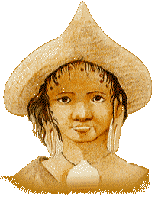
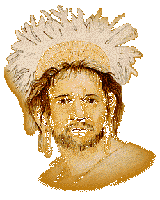
The Polynesian name of the island is Rapanui, which is a name given by a Tahitian visitor in the 19th century who says that the island looked like the Tahitian island of 'Rapa,' but bigger, 'Nui.' Inhabitants are of Polynesian descent, but for decades anthropologists have argued the true origins of these people, some claiming that ancient South-American mariners settled the island first.
What many early explorers who visited the island found, was a scattered population with almost no culture they could remember and without any links to the outside world. The Easter islanders were easy prey for 19th century slave traders which depreciated even more their precarious culture, knowledge of the past, and skills of the ancestors.
Easter Island is one of the youngest inhabited territories on Earth, and for most of its history it was the most isolated inhabited territory on Earth. Its inhabitants, the Rapanui, have endured famines, epidemics, civil war, slave raids and colonialism, have seen their population crash on more than one occasion, and created a cultural legacy that has brought them fame out of proportion to their numbers.
First Settlers
Early European visitors to Easter Island recorded the local oral traditions of the original settlers. In these traditions, Easter Islanders claimed that a chief Hotu Matu'a arrived on the island in one or two large canoes with his wife and extended family. They are believed to have been Polynesian.
There is considerable uncertainty about the accuracy of this legend as well as the date of settlement. Published literature suggests the island was settled around 300-400 CE, or at about the time of the arrival of the earliest settlers in Hawaii. Some scientists say that Easter Island was not inhabited until 700-800 CE. This date range is based on glottochronological calculations and on three radiocarbon dates from charcoal that appears to have been produced during forest clearance activities.
Moreover a recent study which included radiocarbon dates from what is thought to be very early material suggests that the island was settled as recently as 1200 CE. This seems to be supported by a 2006 study of the island's deforestation, which could have started around the same time. Any earlier human activity seems to be insignificant if there was any at all.
The Austronesian Polynesians, who first settled the island, are likely to have arrived from the Marquesas Islands from the west. These settlers brought bananas, taro, sugarcane, and paper mulberry, as well as chickens and Polynesian Rats. The island at one time supported a relatively advanced and complex civilization.
South American Links
The Norwegian adventurer Thor Heyerdahl believed that cultural similarities exist between Easter Island and South American Indian cultures which he suggested might have resulted from some settlers arriving from the continent.[6] According to local legends, a group of long-eared people called hanau epe arrived on the island sometime after the original inhabitants, introducing the stone carving technology and attempting to enslave the population.
Some early accounts of the legend place hanau epe as the original residents and the contemporary Easter Islanders as later immigrants coming from Oparo. After mutual suspicions erupted in a violent clash, the hanau epe were overthrown and exterminated, leaving only one survivor.
The fact that the sweet potato, a staple of the pre-contact Polynesian diet, is of South American origin, and that there is no evidence that its seed could spread by floating across the ocean, indicates that there must have been some contact between the two cultures.
Either Polynesians traveled to South America and back, or Indian balsa rafts drifted to Polynesia, possibly unable to make a return trip because of their less developed navigational skills and more fragile boats, or both. Polynesian connections in South America have been claimed to exist among the Mapuche Indians in central and southern Chile.
The Polynesian name for the small islet of Sala y Gómez (Manu Motu Motiro Hiva, "Bird's islet on the way to a far away land") east of Easter Island has also been seen as a hint that South America was known before European contacts. Further complicating the situation is that the word Hiva ("far away land") was also the name of the islanders' legendary home country. Inexplicable insistence on an eastern origin for the first inhabitants was unanimous among the islanders in all early accounts.
Jacob Roggeveen's expedition of 1722 gives us our first description of the islanders. They were "of all shades of color, yellow, white and brown" and they distended their ear lobes so greatly with large disks that when they took them out they could "hitch the rim of the lobe over the top of the ear".
Roggeveen also noted how some of the islanders were "generally large in stature". Islanders' tallness was also witnessed by the Spanish who visited the island in 1770, measuring heights of 196 and 199 cm.
DNA sequence analysis of Easter Island's current inhabitants indicates that the 36 people living on Rapanui who survived the devastating intercine wars, slave raids and epidemics of the 19th century and had any offspring, were Polynesian. Furthermore, examination of skeletons offers evidence of only Polynesian origins for Rapanui living on the island after 1680.
Mainstream archeology is skeptical about any non-Polynesian influence on the island's prehistory, but the discussion has become political.
Pre-European Society
According to legends recorded by the missionaries in the 1860s, the island originally had a very clear class system, with an ariki, king, wielding absolute god-like power ever since Hotu Matua had arrived on the island. The most visible element in the culture was production of massive moai that were part of the ancestral worship.
With a strictly unified appearance, moai were erected along most of the coastline, indicating a homogeneous culture and centralized governance. In addition to the royal family, the island's habitation consisted of priests, soldiers and commoners.
The last king, along with his family, died as a slave in the 1860s in the Peruvian mines. Long before that, the king had become a mere symbolic figure, remaining respected and untouchable, but having nominal authority.
For unknown reasons, a coup by military leaders called matatoa had brought a new cult based around a previously unexceptional god Make-make. In the cult of the birdman (Rapanui: tangata manu), a competition was established in which every year a representative of each clan, chosen by the leaders, would swim across shark-infested waters to Motu Nui, a nearby islet, to search for the season's first egg laid by a manutara (sooty tern).
The first swimmer to return with an egg and successfully climb back up the cliff to Orongo would be named "Birdman of the year" and secure control over distribution of the island's resources for his clan for the year. The tradition was still in existence at the time of first contact by Europeans. It ended in 1867. The militant birdman cult was largely to blame for the island's misery of the late 18th and 19th centuries. Each year's winner and his supporters short-sightedly pillaged the island after the victory. With the island's ecosystem fading, destruction of crops quickly resulted in famine, sickness and death.
European accounts in 1722 (Dutch) and 1770 (Spanish) reported seeing only standing statues, but by James Cook's visit in 1774 many were reported toppled. The huri mo'ai - the "statue-toppling" - continued into the 1830s as a part of fierce internecine wars. By 1838, the only standing moai were on the slopes of Rano Raraku and Hoa Hakananai'a at Orongo. In about 60 years, islanders had deliberately destroyed the main part of their ancestors' heritage. In modern times, moai have been restored at Orongo, Ahu Tongariki, Ahu Akivi and Hanga Roa.
European Contacts
The first recorded European contact with the island was on 5 April (Easter Sunday) 1722 when Dutch navigator Jacob Roggeveen visited for a week and estimated there were 2,000 to 3,000 inhabitants on the island (this was an estimate, not a census, and archaeologists estimate the population may have been as high as 10,000 to 15,000 a few decades earlier). His party reported "remarkable, tall, stone figures, a good 30 feet in height", the island had rich soil and a good climate and "all the country was under cultivation". Fossil pollen analysis shows that the main trees on the island had gone 72 years earlier in 1650.
The civilization of Easter Island was long believed to have degenerated drastically during the century before the arrival of the Dutch, as a result of overpopulation, deforestation and exploitation of an extremely isolated island with limited natural resources. The Dutch reported that a fight broke out in which they killed ten or twelve islanders.
The next foreign visitors (November 15, 1770) were two Spanish ships, San Lorenzo and Santa Rosalia, sent by the Viceroy of Peru, Manuel Amat, and commanded by Felipe González de Ahedo. They spent five days in the island, performing a very thorough survey of its coast, and named it Isla de San Carlos, taking possession on behalf of King Charles III of Spain, and ceremoniously erected three wooden crosses on top of three small hills on Poike. They reported the island as largely uncultivated, with a seashore lined with stone statues.
Four years later, in 1774, British explorer James Cook visited Easter Island, he reported the statues as being neglected with some having fallen down; no sign of the three crosses and his botanist described it as "a poor land". He had a Tahitian interpreter who could partially understand the language as it was Polynesian.
In 1786, the French explorer Jean François de Galaup La Pérouse visited and made a detailed map of Easter Island. He described the island as one tenth cultivated and estimated the population as a couple of thousand.
In 1804, the Russian ship, Neva, visited under the command of Yuri Lisyansky.
In 1816, the Russian ship, Rurik, visited under the command of Otto von Kotzebue.
In 1825, the British ship, HMS Blossom, visited and reported no standing statues.
Easter Island was approached many times during the 19th century, but by now the islanders had become openly hostile towards any attempt to land, and very little new information was reported before the 1860s.
Destruction of Society and Population
A series of devastating events killed almost the entire population of Easter Island in the 1860s.
In December 1862, Peruvian slave raiders struck Easter Island. Violent abductions continued for several months, eventually capturing or killing around 1500 men and women, about half of the island's population. International protests erupted, escalated by Bishop Florentin-Etienne Jaussen of Tahiti.
The slaves were finally freed in autumn, 1863, but by then most of them had already died of tuberculosis, smallpox and dysentery. Finally, a dozen islanders managed to return from the horrors of Peru, but brought with them smallpox and started an epidemic, which decimated the island's population to the point where some of the dead were not even buried.
Contributing to the chaos were violent clan wars with the remaining people fighting over the newly available lands of the deceased, bringing further famine and death among the dwindling population.
The first Christian missionary, Eugène Eyraud, arrived in January 1864 and spent most of that year on the island; but mass conversion of the Rapanui only came after his return in 1866 with Father Hippolyte Roussel and shortly after two others arrived with Captain Jean-Baptiste Dutrou-Bornier. Eyraud was suffering from phthisis (tuberculosis) when he returned and in 1867, tuberculosis raged over the island, taking a quarter of the island's remaining population of 1,200 including the last member of the island's royal family, the 13-year-old Manu Rangi. Eyraud died of tuberculosis in August 1868, by which time the entire Rapanui population had become Roman Catholic.
Dutrou-Bornier
Jean-Baptiste Dutrou-Bornier - arms dealer, gambler, bigamist, murderer, slave dealer, encourager of apostasy and alleged ship wrecker - was to have a long lasting impact on the island. He set up residence at Mataveri, aiming to cleanse the island of most of the Rapanui and turn the island into a sheep ranch. He married Koreto, a Rapanui, and appointed her Queen, tried to persuade France to make the island a protectorate, and recruited a faction of Rapanui whom he allowed to abandon their Christianity and revert to their previous faith. With rifles, a cannon, and hut burning, supporters ran the island for several years.
Dutrou-Bornier bought up all of the island apart from the missionaries area around Hanga Roa and moved a couple hundred Rapanui to Tahiti to work for his backers.
In 1871 the missionaries, having fallen out with Dutrou-Bornier, evacuated 275 Rapanui to Mangareva and Tahiti, leaving only 230 on the island. Those who remained were mostly older men. Six years later, there were just 111 people living on Easter Island, and only 36 of them had any offspring.
In 1876 Dutrou-Bornier was murdered in an argument over a dress, though his kidnapping of pubescent girls may also have motivated his killers.
From that point on and into the present day, the island's population slowly recovered. But with over 97% of the population dead or left in less than a decade, much of the island's cultural knowledge had been lost.
Neither his first wife back in France, who was heir under French law, nor his second wife on the island, who briefly installed their daughter Caroline as Queen, were to keep much from his estate. But to this day much of the island is a ranch controlled from off-island and for more than a century real power on the island was usually exercised by resident non-Rapanui living at Mataveri. An unusual number of shipwrecks had left the island better supplied with wood than for many generations, whilst legal wrangles over Dutrou-Bornier's land deals were to complicate the island's history for decades to come.
1878-1888
Alexander Salmon, Jr was the brother of the Queen of Tahiti, and the son of an English merchant adventurer, and a member of the mercantile dynasty that had bankrolled Dutrou-Bornier. He arrived on the island in 1878 with some fellow Tahitians and returning Rapa Nui and ran the island for a decade. As well as producing wool he encouraged the manufacture of Rapanui artworks, a trade that thrives to this day. It was this era of peace and recovery that saw the linguistic change from old Rapanui to the Tahitian-influenced modern Rapanui language, and some changes to the island's myths and culture to accommodate other Polynesian and Christian influences (notably, Ure, the old Rapanui word for "penis", was dropped from many people's names).
This era saw the first "archaeological" excavations on the island, in 1882 by the Germans on the SMS Hyäne and in 1886 the USS Mohican whose crew blew open Ahu Vinapu with dynamite.
Father Roussel made a number of pastoral visits in the decade, but the only permanent representatives of the church were Rapanui catechists including, from 1884, Angata, one of the Rapanui who had left with the missionaries in 1871. Despite the lack of a resident priest to regularly perform mass, the Rapanui had returned to Roman Catholicism, but there remained some tension between temporal and spiritual power as Father Roussel disapproved of Salmon because of his Jewish paternity.
Annexation to Chile
Easter Island was annexed by Chile on September 9, 1888 by Policarpo Toro, by means of the "Treaty of Annexation of the island" (Tratado de Anexión de la isla), that the government of Chile signed with the Rapanui people.
Until the 1960s, the surviving Rapanui were confined to the settlement of Hanga Roa and the rest of the island was rented to the Williamson-Balfour Company as a sheep farm until 1953. The island was then managed by the Chilean Navy until 1966 and at that point the rest of the island was reopened.
1914
1914 was an eventful year for the 250 residents of Easter Island. In March, the Routledge Expedition landed and began a 17 month archaeological and ethnographic survey of the island.
In June, after Mr Scoresby Routledge fired a Rapanui worker for stealing biscuits and the Rapanui revolted. Led from the Roman Catholic church by their Catechist Angata, who claimed to be acting on the instructions from God that she was receiving in her dreams, the Rapanui declared independence, crossed the wall and took hundreds of sheep and cattle. The revolt was quelled in August by the annual supply ship from Chile which then deported Angata's son.
In October, the German East Asia Squadron including the Scharnhorst, Dresden, Leipzig, Emden and Gneisenau rendezvoused off Hanga Roa before sailing on to Coronel and the Falklands.
In December, another German warship the commerce raider SMS Prinz Eitel Friedrich visited and released 48 British and French merchant seamen on the island, supplying much needed labour for the archaeologists.
Today
Since being given Chilean citizenship in 1966, the Rapanui have re-embraced their ancient culture, or what could be reconstructed of it
Mataveri International Airport is the island's only airport. In the 1980s, its runway was lengthened by the U.S. space program to 3,318 m (10,885 ft) so that it could serve as an emergency landing site for the space shuttle. This enabled regular wide body jet services and a consequent increase of tourism on the island, coupled with migration of people from mainland Chile which threatens to alter the Polynesian identity of the island. Land disputes have created political tensions since the 1980s, with part of the native Rapanui opposed to private property and in favor of traditional communal property.
On 30 July 2007, a constitutional reform gave Easter Island and Juan Fernández Islands the status of special territories of Chile. Pending the enactment of a special charter, the island will continue to be governed as a province of the Valparaíso Region.
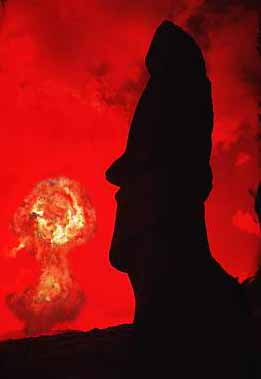
Hotu Matu'a was the legendary first settler and ariki mau ("supreme chief" or "king") of Easter Island. Hotu Matu'a and his two canoe (or one double hulled canoe) colonising party were Polynesians from the now unknown land of Hiva (probably the Marquesas). They landed at Anakena beach and his people spread out across the island, sub-divided it between clans claiming descent from his sons, and lived for more than a thousand years in their isolated island home at the southeastern tip of the Polynesian Triangle.
Polynesians first came to Rapa Nui/Easter Island sometime between 300 CE and 800 CE. These are the common elements of oral history that have been extracted from island legends. Linguistic, DNA and Pollen analysis all point to a Polynesian first settlement of the island at that time, but it is unlikely that other details can be verified. During this era the Polynesians were colonizing islands across a vast expanse of the Pacific Ocean. Hotu Matua led his people from Hiva; linguistic analysis comparing Rapanui to other Polynesian languages suggests this was the Marquesas Islands.
It is said that Hau-Maka had a dream in which his spirit travelled to a far country, to help look for new land for King Hotu Matu'a. In the dream, his spirit travelled to the Mata ki te Rangi (Eyes that look to the Sky). The island has also been called "Te Pito 'o te Käinga", which means "the Center of the Earth." Both islands are commonly said to be Easter Island.
When Hau-Maka woke, he told the King. The King then ordered seven men to travel to the island from Hiva (a mythical land) to investigate. After they found the land, they returned to Hiva. The King and many more travelled to this new island.
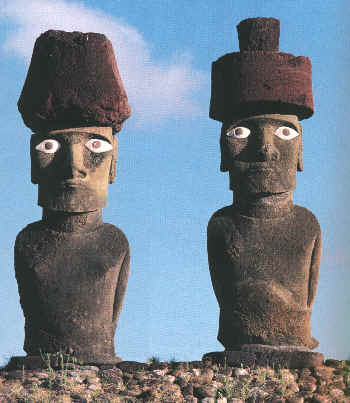
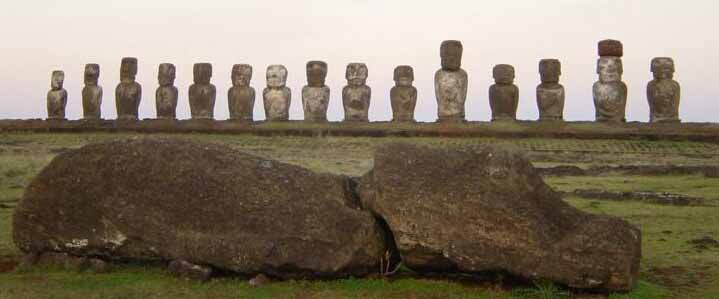
When we think of Eastern Island we think of of huge stone carved figures, monoliths, that dot the coastline. They are called Moai - (pronounced moe-eye). Moai are statues carved of compressed volcanic ash on Rapa Nui (Easter Island). The statues are all monolithic, that is, carved in one piece. However, less than about one-fifth of the statues that were moved to ceremonial sites and then erected once had red stone cylinders pukau placed on their heads. These "topknots," as they are often called, were carved in a single quarry known as Puna Pau.
About 95% of the 887 moai known to date were carved out of compressed volcanic ash at Rano Raraku, where 394 moai still remain visible today. Recent GPS mapping in the interior will certainly add additional moai to that count. The quarries in Rano Raraku appear to have been abandoned abruptly, with many incomplete statues still in situ.
However, the pattern of work is very complex and is still being studied. Practically all of the completed moai that were moved from Rano Raraku and erected upright on ceremonial platforms were subsequently toppled by native islanders in the period after construction ceased.
Although usually identified as "heads" only, the Moai are actually one piece figures with heads and truncated torsos.
The most widely-accepted theory is that the statues were carved by the Polynesian colonizers of the island beginning by about A.D. 1000-1100. In addition to representing deceased ancestors, the Moai, once they were erect on ceremonial sites, may also have been regarded as the embodiment of powerful living chiefs. They were also important lineage status symbols.
The moai were carved by a distinguished class of professional carvers who were comparable in status to high-ranking members of other Polynesian craft guilds. The statues must have been extremely expensive to craft; not only would the actual carving of each statue require effort and resources, but the finished product was then hauled to its final location and erected.
It is not known exactly how the moai were moved but the process almost certainly required human energy, ropes, wooden sledges and/or rollers. Another theory is that the moai may have been "walked" by rocking them forward.
By the mid-1800s, all the moai outside of Rano Raraku and many within the quarry itself had been knocked over. Today, about 50 moai have been re-erected on their ceremonial sites.
Ancient island legends speak of a clan chief called Hotu Matu'a, who left his original home in search of a new one. The place he chose is now known to us as Easter Island. When he died, the island was divided between his six sons and then, later, sub-dividied among their descendants.
The islanders may have believed that their statues would capture the chiefs' "mana" (supernatural powers). They may have believed that by concentrating mana on the island good things would result, rain would fall and crops would grow. The settlement legend is a fragment of what was surely a much more complicated and many-faceted, mythic sketch, and it has changed over time.
Ron Fisher in his work Easter Island Brooding Sentinels of Stone, mentions as one explanation for the statues that "two classes of people, the-so-called Long Ears and Short Ears, lived on the island. The Short Ears were enslaved by the Long Ears, who forced the Short Ears to carve the Moai. After many generations and during a rebellion, the Short Ears surprised the Long Ears killing them all, which explains the abrupt end of the statue-carving.
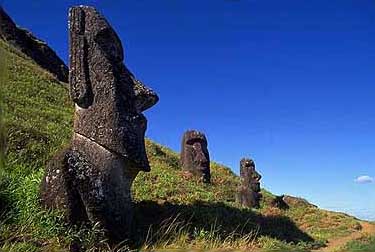
Long Ears
>
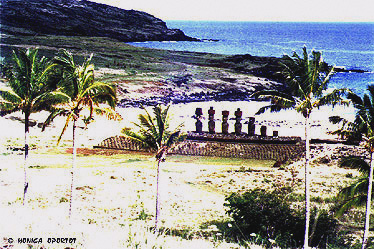
but most face inland to watch over the villages.
Many of the were buried up to their shoulders 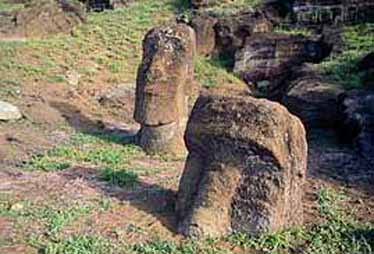
and thereby appearing as disembodied heads.
All of the Moai were toppled in tribal wars about 250 years ago. Many have recently been rebuilt, construction beginning in the 1950's. They sit on rocky lava strewn about telling a story of fallen monuments of a long lost civilization who created them. The Moai were depictions of their ancestors. The Rapa Nui were ancestor worshipers and only had one diety - Make Make. The Moai were excavated for the first time by Thor Heyerdahl in the 1950's and were photographed at that time.
Moai sit on platforms or ceremonial shrines called Ahu.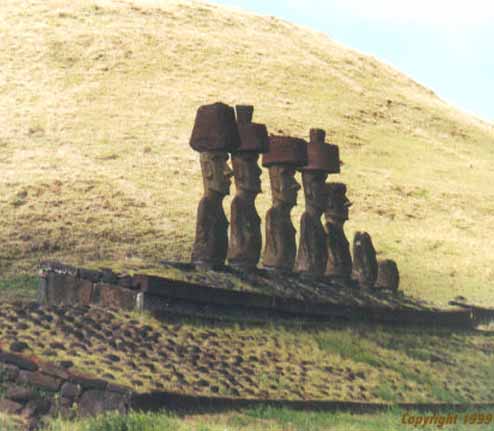
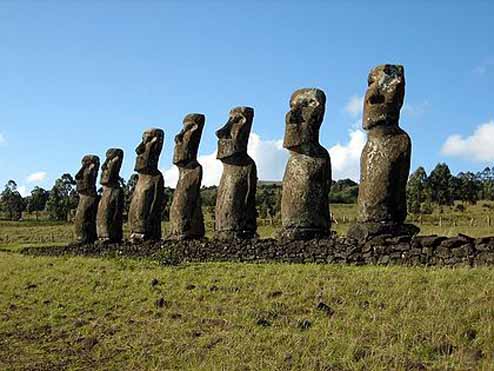
Ahu Akivi is an especially sacred place. Ahu Akivi is a sanctuary and celestial observatory built about 1500 AD which was the subject of the first serious restoration accomplished on Easter Island by archaeologists William Mulloy and Gonzalo Figueroa, with excellent results. As in the case of many religious structures on Easter Island, it has been situated with astronomical precision - it's seven statues look towards the point where the sun sets during the equinox.
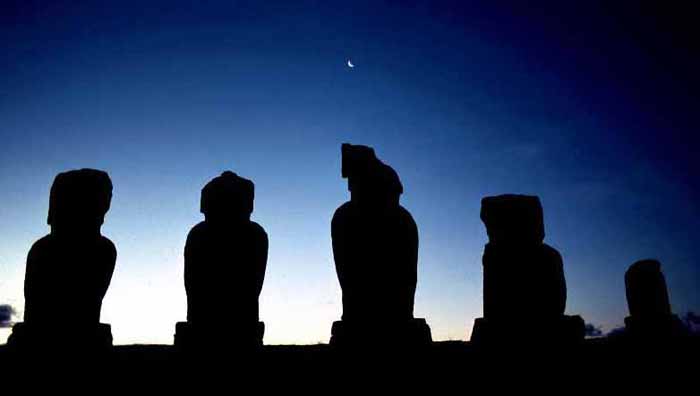
Aligned with the moon
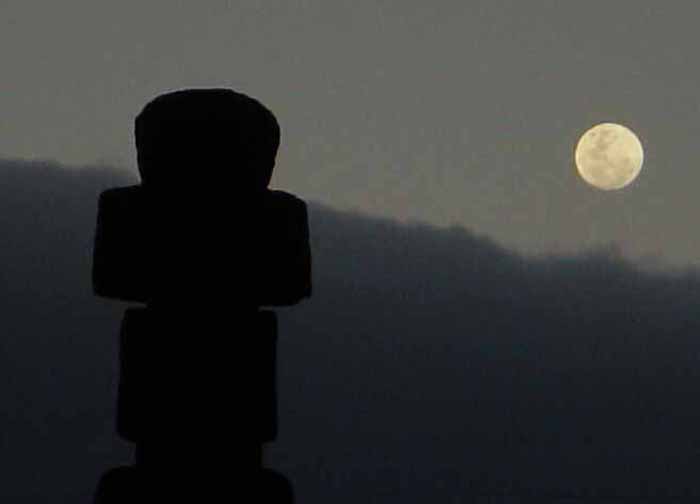
Ahu Akivi is an unusual site in several respects. A low ahu supports 7 statues all very similar in height and style. The site is odd in that it is located far inland and the statues were erected to face the ocean. The only site where this was done. Like other Easter Island sites the statues were found knocked off the ahu, lying face down in the ground. In 1960, Archeologist William Mulloy's team spent several months raising the statues to their original positions.
During the excavation and restoration of this site many cremation pits were uncovered behind the ahu. The pits contained fragments of bone, shells, fishing implements, and obsidian flakes. Whether sites like these were used regularly for cremations and or burials is not certain. At other sites skeletons have been found buried within the ahu structure, but these burials are believed to have occurred after the statues were toppled.
Folklore holds that its seven moai represent the seven young explorers that legend says the Polynesian King Hotu Matu'a dispatched from across the seas, probably from the Marquesas Islands, to find this new homeland for him and his people. They are among the few moai that face the sea.
These seven stone giants may well symbolize those seven explorers, but no one knows for sure. Just as no one knows what any of the moai really represent or why only a few of them face the sea.
The generally accepted theory is that these majestic stone statues were built to honor Polynesian gods and deified ancestors such as chiefs and other figures important in the island's history. Most of them are attributed to the 14th and 15th centuries, although some were erected as long ago as the 10th Century.
Their function, it is believed, was to look out over a village or gravesite as a protector. They may also have been status symbols for villages or clans.
The seven at Ahu Akivi each stand about 16 feet high and weigh about 18 tons. The tallest moai on the island exceed 30 feet. Moai in the range of 12 to 20 feet are common. Even the occasional tiny moai that you come across are at least 6 feet high.
The ahu of Easter Island vary in length - the longest one is 300 feet, while some that hold one moai are only several feet long. Each ahu has a stone masonry base that slopes upward to a high terrace upon which the moai rest. Some terraces are as high as 15 feet above ground level. All are fairly wide - the bases of the moai that stand upon them measure as much as 10 feet long by 8 or 9 feet wide.
The island's volcanic rock from which they were carved is softer and lighter than most other rock, but even the smallest moai weighs several tons. Some of the moai have been estimated to weigh as much as 80 to 90 tons.
Many of the moai - there are hundreds of them - are erected at sites miles from the quarry at which they were carved. How could so few people move them even a couple of feet, let alone several miles, and without breaking them?
And once they did move them, how did they erect them? Even today, using powerful cranes, it would be no simple task.
 Maoi on Easter Island Google Videos
Maoi on Easter Island Google Videos Giant statues give up hat mystery BBC - September 6, 2009 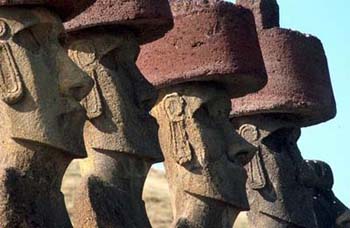
Go on your own Easter Island adventure MSNBC - November 8, 2005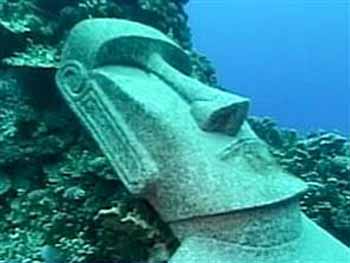
'Mata' reminded me of the Greek word Mati or Eye.
I discovered Matariki the Maori name for the constellation Pleiades or Seven Sisters. Literally it means "little eyes" mata riki or "eyes of god" mata ariki.
The Eye is the God, All Seeing Eye, Masonic Program, Lens of Time, the creational source through which consciousness experiences in physical reality.
Great Pyramid who is a priest bringing gifts when the Pleiades are rising.
The Old Rapanui name 'Mata Ura', 'The red eye' is the designation of Mars.
2012 is our program designation, return through the eye of consciousness in the alchemy of time.
Many Rapa Nui people believe that the statues were moved and erected by 'mana' a magical force. Great kings of a long-gone era simply used their mana to command the moai to move to the distant sites and stand there. Mana is a word and concept you hear frequently in South Seas lore. The people of Rapa Nui believed that the moai also possessed mana, which was instilled at the time their white coral eyes were put in place, and that the moai used their mana to protect the people of the island. Today none of the moai have genuine coral eyes - and thus the mana is no more.
The intervention of Extraterrestrials - the most infamous of these writers is Erich Von Daniken who suggests that a small group of 'intelligent beings' were stranded there and taught the natives to make 'robot-like' statues. His main thrust is that the stone from which the statues are made is not found on the island- a complete fabrication. This links with theories that Easter island was once part of the lost civilization of flying machines.
Other theories include - men sliding the moai along on layers of yams and sweet potatoes.
The generally accepted belief is that they were transported on sledges or log rollers and then levered erect using piles of stones and long logs.
Thor Heyerdahl, whose books Kon-Tiki and Aku-Aku stirred great interest in Easter Island, conducted an experiment showing that an upright stone statue could be moved using ropes, tilting and swiveling it along. But the experiment was conducted on a flat surface for only a short distance, and this theory, like Heyerdahl's theory that the islands of the South Pacific were settled from east to west from South America rather than from west to east from Southeast Asia, is not considered plausible.
All but a few of the moai of Easter Island were carved at Rano Raraku, a volcanic cone that contains a crater lake. It is an eerie spot. Scattered all around Rano Raraku are 394 moai in every stage of evolution. Some are fallen - a common sight around the island - and some appear to have only heads, although they are really full figures that have been nearly buried by soil over the centuries. For reasons that remain a mystery, it appears that the workers at Rano Raraku set down their tools in the middle of a multitude of projects - and the moai-building abruptly ceased.
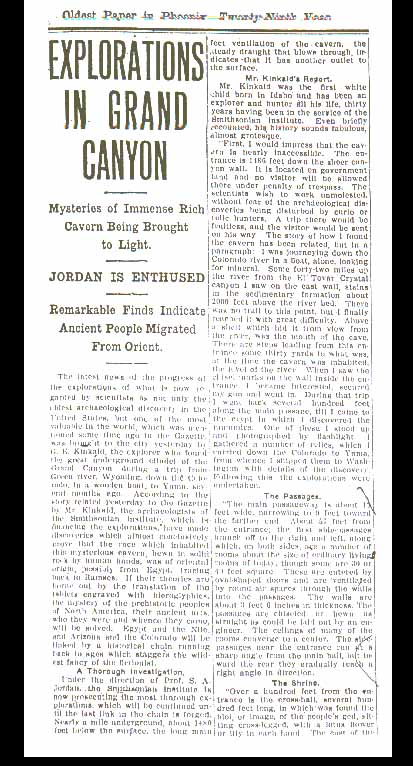
Replies
Rongorongo is the hieroglyphic script of Easter Island. It has remained a mystery since its discovery. For over a hundred years, controversy has raged over the meaning and source of these enigmatic characters.
There are only 21 known tablets in existence, scattered in museums and private collections. Tiny, remarkably regular glyphs, about one centimeter high, highly stylized and formalized, are carved in shallow grooves running the length of the tablets. Oral tradition has it that scribes used obsidian flakes or shark teeth to cut the glyphs and that writing was brought by the first colonists led by Hotu Matua. Last but not least, of the twentyone surviving tablets three bear the same text in slightly different "spellings", a fact discovered by three schoolboys of St Petersburg (then Leningrad), just before World War II.
In 1868 newly converted Easter Islanders send to Tepano Jaussen, Bishop of Tahiti, as a token of respect, a long twine of human hair, wound around an ancient piece of wood. Tepano Jaussen examines the gift, and, lifting the twine, discovers that the small board is covered in hieroglyphs.
The bishop, elated at the discovery, writes to Father Hippolyte Roussel on Easter Island, exhorting him to gather all the tablets he can and to seek out natives able to translate them. But only a handful remain of the hundreds of tablets mentioned by Brother Eyraud only a few years earlier in a report to the Father Superior of the Congregation of the Sacred Heart.
Some say they were burnt to please the missionaries who saw in them evil relics of pagan times. Some say they were hidden to save them from destruction. Which side should we believe? Brother Eyraud had died in 1868 without having ever mentioned the tablets to anyone else, not even to his friend Father Zumbohm, who is astounded at the bishop's discovery. Monsignor Jaussen soon locates in Tahiti a laborer from Easter Island, Metoro, who claims to be able to read the tablets. He describes in his notes how Metoro turns each tablet around and around to find its beginning, then starts chanting its contents.
The direction of writing is unique. Starting from the lefthand bottom corner, you proceed from left to right and, at the end of the line, you turn the tablet around before you start reading the next line. Indeed, the orientation of the hieroglyphs is reversed every other line. Imagine a book in which every other line is printed backtofront and upsidedown. That is how the tablets are written! Jaussen was not able to decipher the tablets.
There are also many zoomorphic figures, birds especially, fish and lizards less often. The most frequent figure looks very much like the frigate bird, which happens to have been the object of a cult, as it was associated with MakeMake, the supreme god.
When you compare the tablets which bear the same text, when you analyze repeated groups of signs, you realize that writing must have followed rules. The scribe could choose to link a sign to the next, but not in any old way. You could either carve a mannikin standing, arms dangling, followed by some other sign, or the same mannikin holding that sign with one hand. You could either carve a simple sign (a leg, a crescent) separate from the next, or rotate it 90 degrees counterclockwise and carve the next sign on top of it.
All we can reasonably hope to decipher some day is some two to three lines of the tablet commonly called Mamari. You can clearly see that they have to do with the moon. There are several versions of the ancient lunar calendar of Easter Island.
--------------------------------------------------------------------------------
Petroglyphs
On Easter Island, petroglyphs are located in every sector of the island where there are suitable surfaces. Favored locations are smooth areas of lava flow (called "papa" in Rapanui), or on smooth basalt boulders. Most of these surfaces occur along coastal areas and often are associated with major ceremonial centers. Some important ahu have, as part of their structure, elegantly carved basalt stones (pa'enga), with petroglyphs on them. Paintings survive in caves or in some of the stone houses at 'Orongo where they are protected against the weathering process.
Thousands of petroglyphs, rock carvings, can be found on Easter Island. Many represent animals, notably birds or anthropomorphic birdmen. One of the most famous motifs on Easter Island is that of birdman - half-man, half bird image that was connected to cult events at the sacred site of 'Orongo. A bit of background on the culture is necessary to explain this unusual cult.
After the demise of the statue building, in the last days before the invasion by Peruvian slave traders, there arose a cult of the Birdman (Tangata Manu). The birdman was seen as the representative on earth of the creator god Makemake, and eventually, this cult surpassed the traditional power of the king ariki.
Once a year, representatives from each clan would gather at the ceremonial village of Orongo and swim to Motu Nui, a nearby Islet to search for the egg of the Sooty Tern. On his return, the competitor presented the egg to his representative who was then invested with the title of Tangata Manu. He then went down to Mataveri and from there was led in procession to the southwest exterior slope of Rano Raraku, where he remained in seclusion for a year. The Birdman ritual was still in existence when Europeans arrived on Easter Island - therefore historically documented. It was also featured quite prominently in Kevin Costner's film "Rapa Nui".
In Hanga Roa -a sprawling and pleasant community where the island's 2,775 residents live because it's the only area on the island with electricity and running water. The most interesting souvenirs are miniature wood and stone carvings of moais, though some stone samples up to 6 feet tall are available.
--------------------------------------------------------------------------------
Art
M.H. de Young Memorial Museum
Moai Kavakava
A bearded emaciated man whose ribs and vertebrae are grotesquely extended. It is said to represent the spirits of dead ancestors. According to the local tradition, as Chief Tuu-ko-ihu was returning home, he saw two such spirits who had protruding ribs and hollow bellies. These Aku Aku later appeared to him in a dream.
Other Rapa Nui wood carvings include: statues of female figures (moai pa'a pa'a), paddles (rapa), clubs (ua), staffs ('ao), lizards and birdman images (tangata manu).
Today, most of the original wood sculptures reside in museums around the world. The islanders still carve these statues, continuing a tradition which, to this day, commands respect and admiration from visitors.
--------------------------------------------------------------------------------
Tattoo
Tattoos on various parts of the body is a popular custom.
Images often depict stories from the past and the present.
Old methods of tattooing have given way to more modern sanitary ones.
--------------------------------------------------------------------------------
Cannibalism
Easter Islanders know that their ancestors were kai-tangata, 'man-eaters'. Some make jokes about it, others take offense at any allusion to this custom which has become in their eyes barbarous and shameful.
According to Father Roussel, cannibalism did not disappear until after the introduction of Christianity. Shortly before this, the natives are said to have eaten a number of men, including two Peruvian traders. Cannibal feasts were held in secluded spots, and women and children were rarely admitted. The natives told Father Zumbohm that the fingers and toes were the choicest morsels. The captives destined to be eaten were shut up in huts in front of the sanctuaries. There they were kept until the moment when they were sacrificed to the gods.
The Easter Islanders' cannibalism was not exclusively a religious rite or the expression of an urge for revenge: it was also induced by a simple liking for human flesh that could impel a man to kill for no other reason than his desire for fresh meat. (Man was the only large mammal whose flesh was available) Women and children were the principal victims of these inveterate cannibals.
The reprisals that followed such crimes were all the more violent because an act of cannibalism committed against the member of a family was a terrible insult to the whole family. As among the ancient Maoris, those who had taken part in the meal were entitled to show their teeth to the relatives of the victim and say, 'Your flesh has stuck between my teeth'. Such remarks were capable of rousing those to whom they were addressed to a murderous rage not very different from the Maly amok.
- Easter Island, A Stone-Age Civilization of the Pacific